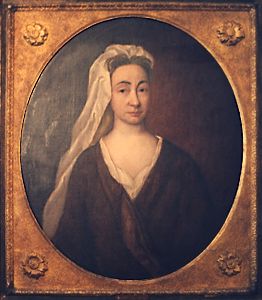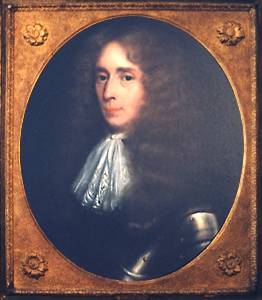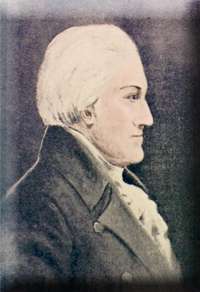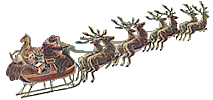 |
 |
| Margaretta van Slichtenhorst | Colonel Philip Schuyler |
Colonel Philip Schuyler
 (1627, Amsterdam North Holland Netherlands) (1627, Amsterdam North Holland Netherlands)
 (9 May 1683, Beverwyck NY) (9 May 1683, Beverwyck NY)
+ Margaretta van Slichtenhorst  12 Dec 1650 12 Dec 1650
 (1634, Nykerk, Gelderland, Netherlands) (1634, Nykerk, Gelderland, Netherlands)
 (27 Jun 1711, NY) (27 Jun 1711, NY)
Children:
 Gysbert Schuyler Gysbert Schuyler
 Gertruyd Schuyler Gertruyd Schuyler
 [married Colonel Stephen Van Cortlandt] [married Colonel Stephen Van Cortlandt]
 Alida Schuyler Alida Schuyler
 Mayor Peter Schuyler Mayor Peter Schuyler
 [married Engaltie Van Schaick] [married Engaltie Van Schaick]
 Captain Brandt Schuyler Captain Brandt Schuyler
 [married Cornelia Van Cortlandt] [married Cornelia Van Cortlandt]
 Captain Arent (Francis) Schuyler Captain Arent (Francis) Schuyler
 [married Janneke Teller] [married Janneke Teller]
 Sybilla Schuyler Sybilla Schuyler
 [died at 1 month] [died at 1 month]
 Colonel Philip Schuyler Colonel Philip Schuyler
 [married Elizabeth De Mayer] [married Elizabeth De Mayer]
 Colonel Johannes Schuyler Colonel Johannes Schuyler
 [married Elizabeth Staats] [married Elizabeth Staats]
 Margareta Schuyler Margareta Schuyler
 [married Jacobus VerPlanck] [married Jacobus VerPlanck]
I'm young Margarita van Slichtenhorst,
My father's the Master, we call him Baas,
Of de Heer van Renssalaer's Bouwerie,
This brought us here from the Zuider Zee.
My mother is dead, and I'm all alone
To care for my father's simple home,
But I try to do it as well as may be,
Though I long for my home by the Zuider Zee.
My father's a man who knows so much,
Though you'd not understand his Holland Dutch.
He is not handsome, and yet, you know,
He's brave and kind, and I love him so.
|
Back To Top
Genealogical and Personal Memorial of Mercer County, New Jersey Vol
Philip Pieterse Schuyler, the founder of the family in this country, came from Holland in the fourth decade of the seventeenth century and settled in the neighborhood of Albany. The records show that he was appointed by Governor Stuyvesant in 1656 to the office of vice-director of Fort Orange, now Albany. He discharged the duties, which were both civil and military, in so satisfactory a manner that he retained the position, except at short intervals, until near the end of his life.
His business transactions were large and varied and he became possessed of much valuable real estate, not only in Albany, but along the banks of the Hudson and even on Manhattan Island. He died in Albany, May 9, 1683, having made his will eight days before, disposing of a large property which was divided between his wife and numerous children. He seems to have been highly esteemed by his friends and neighbors and to have enjoyed the full confidence of the leading men of the colony from Governor Stuyvesant down.
Though nothing is positively known as to his antecedents in Holland, the fact that soon after coming to this country he was married to a daughter of the distinguished house of Van Slichtenhorst, and also that he was permitted to display his armorial bearings upon a window of the old Dutch church in Albany, seems proof positive that he came from gentle stock in the old country.
Margareta Van Slichtenhorst, the wife of Philip Pieterse Schuyler, whom he married in 1650, seems to have been a woman of remarkable force of character She was the only daughter of Brant Arentse Van Slichtenhorst.
Margareta inherited from her father his courage and business ability, as also his public spirit. On several occasions when the safety of the colony was threatened by the French and Indians she was the largest single subscriber to funds for its defense. She administered her husband's estate with such success that it became one of the largest in the colony. She died in 1711 at the ripe age of eighty-two years.
Missing Source Notation
The FLATTS on the river front at Watervliet, just on the northern outskirts of Albany, though part of it was probably built by the Van Rennselaers as early as 1654 and repaired or rebuilt by them in 1668, became a Schuyler house in 1672, when Philip Pieterse Schuyler bought the bouwerij on the river front, and it so remained until very recent years.
From Philip Pieterse The Flatts descended to his son Pieter Philipse, that picturesque and sterling personage the Indians called "Quider," whom they both feared and loved because of his just dealings and integrity.
From "Quider" The Flatts passed to his son, Colonel Philip Pieterse, who married his cousin, Margarita Schuyler. This lady, commonly known in her day as "Madame Schuyler" or "Aunt Schuyler," was the subject of Memoirs of an American Lady.
Colonel Schuyler died in 1758, and not long afterwards The Flatts caught fire and the flames destroyed the roof and interior. Madame Schuyler got the wing of her house rebuilt. The main part of The Flatts, facing the river, was rebuilt in its present form a little later.
Abstracts of Wills Vol II 1708-1728
MARGARET SCHUYLER.
In the name of God, Amen. I, Margaret
Schuyler, widow of Phillip Schuyler, sometime of Albany, merchant, being of
sound mind, and considering that there having been some unhappy differences
among my children; the youngest of them being apprehensive that by the strict
rules of the common law, the will made by my said husband and myself on May
1st, 1683, might not be authentick enough to make such equal division among our
eight children. But that Peter Schuyler, eldest son of my deceased husband, Peter
Schuyler, might be entitled to all of the real estate. Yet, not thinking that my son,
Peter Schuyler, would himself endeavor to take any such advantage, he being
present at the making of said will. I give to each of our 8 children an equal part of
all real and personal estate. And I being further willing to dispose of the real and
personal estate, which, by of my husband. And my son Peter, at my request, being agreed with the seven
other children, by deed, dated August 16, 1707, by which all further differences
among them are prevented, I do give to my eight children, Gertruy, Alida, Peter,
Arent, Phillip, Johanes, and Margaret, and to the three children of my son Brant
Schuyler, namely: Phillip, Oliver, and Johanes, all my estate, real and personal.
Provided always, that my son Phillip shall have the farm called the Flatts, with the
utensils, he paying therefor, the sum of œ600, to the rest. And they are all to pay
an equal part of 9 bushels of good merchantable wheat yearly, to the Patroon or
Lord of the Manor of Rensselaerwyck. Mentions "Cornelia Schuyler, widow of my
son Brant Schuyler." I make my sons, Peter and Johanes, and my son in law,
Robert Livingston, husband of my daughter Allida, executors. Signed and sealed
in Albany in my dwelling house.
Witnesses, Iona Rumney, Anthony Caster, John Dunbar. Proved in Albany, June
27, 1711, before William Van Rensselaer, Esq., and of the Judges of the Court of
Common Pleas.
Rensselaerswyck, New York Settlers, 1630-58
According to O'Callaghan, History of New Netherland, 2:69, van
Slichtenhorst was appointed director of the colony Nov. 10, 1646, and sailed with
his family and servants for Virginia Sept. 26, 1647. The records of the colony show
that he arrived March 22, 1648, and held the office of director till July 24, 1652,
when he was succeeded by Jan Baptist van Rensselaer. Between June 29, 1651,
and July 24, 1652, van Slichtenhorst was most of the time at the Manhatans and J.
B. van Rensselaer acted in his stead, for the first two months apparently in
conjunction with Capt. Slijter. April 4, 1650, de Hooges complained to the council
that Director van Slichtenhorst had thus far rendered no accounts. The director
replied that hy wel wat souwde ontfangen dan dat het Antonij de Hooges heeft
opgesnapt (that he would have received something if Antonij de Hooges had not
gobbled it up). Van Slichtenhorst was still in the colony in July 1655 and lived in
Holland in 1660.
|



